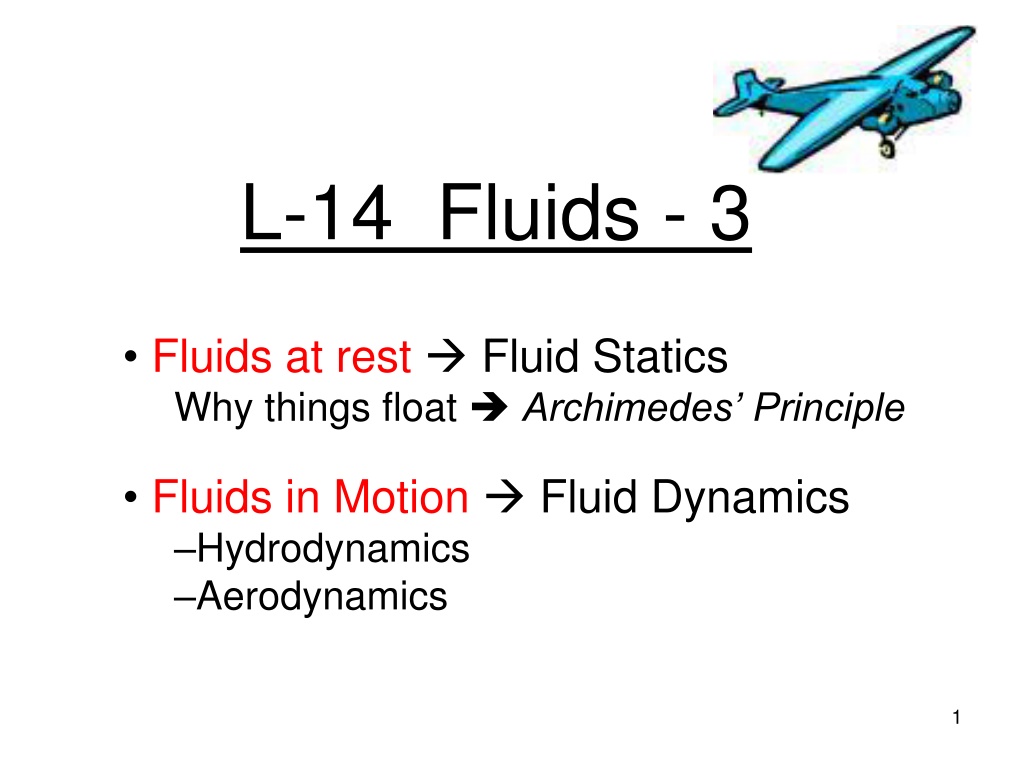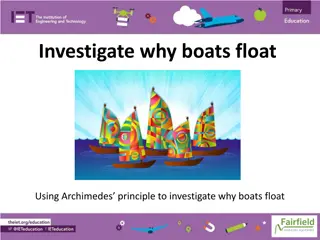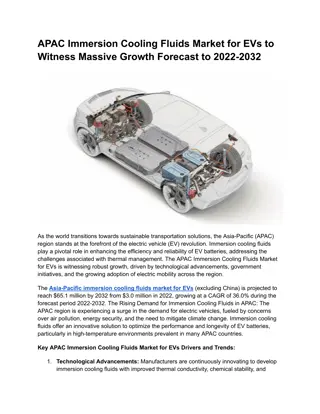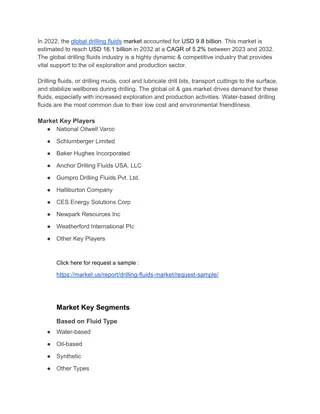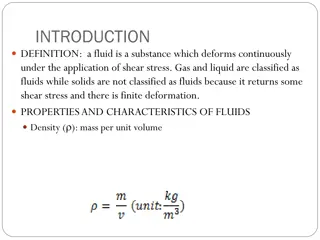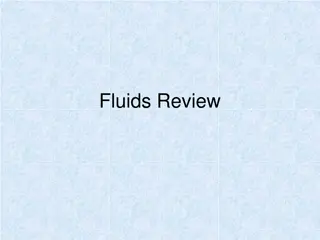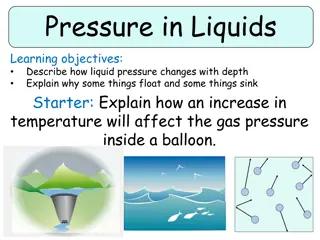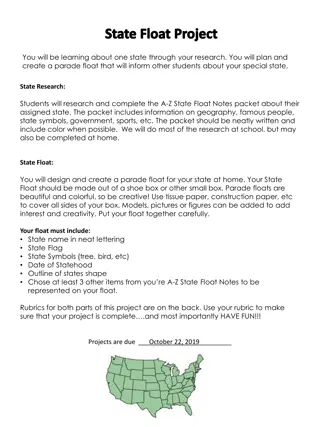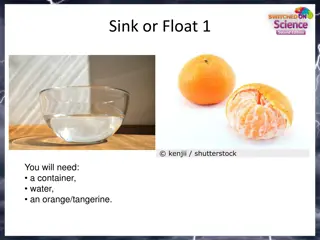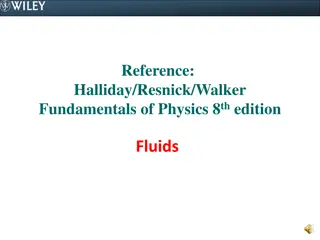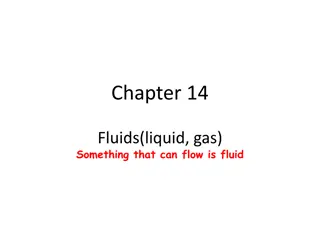Understanding Why Objects Float or Sink in Fluids
Archimedes' principle explains the buoyancy force that causes objects to float or sink in fluids based on the weight of the displaced fluid. The buoyant force must equal the object's weight for it to float. Objects less dense than the fluid will float, while those denser will sink. Discover the science behind buoyancy and why water behaves uniquely due to its density variations.
Download Presentation

Please find below an Image/Link to download the presentation.
The content on the website is provided AS IS for your information and personal use only. It may not be sold, licensed, or shared on other websites without obtaining consent from the author. Download presentation by click this link. If you encounter any issues during the download, it is possible that the publisher has removed the file from their server.
E N D
Presentation Transcript
L-14 Fluids - 3 Fluids at rest Fluid Statics Why things float Archimedes Principle Fluids in Motion Fluid Dynamics Hydrodynamics Aerodynamics 1
Review: Archimedes principle Archimedes principle (buoyancy) is a consequence of the fact that the pressure in a fluid increases with depth. This is simply because as you go deeper into a fluid, there is more fluid above you pushing down. A h WO FB The buoyant force on an object in a fluid equals the weight of the fluid (e.g., water) which it displaces. Anything less dense than water will float in water water weighs 10N/liter each liter of displaced water provides 10 N of buoyant force 2
Will it float? The buoyant force is always present whether or not the object floats The object will float if the buoyant force is big enough to support the object s weight The object will displace just enough water so that the buoyant force = its weight If the object is completely submerged, and the weight of the displaced water is less than the weight of the object, the object will sink Objects that have a density less than water will float- when fully submerged, they weigh less than the water, so the water supports them An object will float in a liquid that is denser than it; a steel bolt will float in mercury 3
Floating or sinking objects lighter object heavier object too heavy FB = W FB = W FB < W The weight of displaced water is less than the weight of the object 4
Will it float? A container having a mass of 500 kg and a volume of 450 liters falls off of the deck of a cargo ship. Will it sink or float? Answer: W = mg = 500 kg x 10 m/s2 = 5000 N Buoyant force required for floating = 5000 N = 10 N/liter x submerged volume of container So, the volume of container must be at least 500 liters Since container volume is only 450 liters, it will sink! 5
Water is weird stuff! density = mass/volume volume = mass/density since the mass is constant volume ~ 1/density This is more common- liquid contracts as temperature is lowered ice is expanding Maximum density at T = 4 C The pressure of expanding ice can break steel pipes. 6
Why does ice float? Water, the most plentiful substance on earth is also one of the most unusual in its behavior in that it expands when it freezes. Since it expands, the density of ice is slightly less than the density of water (958 kg/ m3 as compared to 1000 kg/ m3 for water). So the part of the iceberg above the surface contains less than 10% of the total volume. 7
Fluid Flow fluid dynamics A Swiss mathematician, born in 1700. He applied the laws of mechanics to the problem of fluid flow He developed the basic principle that explains, for example, how airplanes stay up in the air. Daniel Bernoulli 8
How do we measure fluid flow? We can time how long it takes to fill a bucket, say 30 seconds the flow rate is then 1 bucket say per 30 seconds in other words, the flow rate is volume of fluid per unit time gallons per min (gpm), liters/s, cubic feet per min (cfm), or m3/s QV = volume flow rate 9
Volume flow rate QV If the water comes out of a tube of cross sectional area A with a flow speed u the volume flow rate = QV = u A (m/s m2) u m3/s A To measure u just see how long it takes to fill a gallon jug from a hose and measure the diameter of the hose. 10
Mass flow rate Qm We could also measure how much mass comes out per unit time kg/s for example if you are using a fluid of density coming out of a hose of cross sectional area A with speed v the mass flow rate is mass flow rate = Qm = u A = QV The mass flow rate is just the volume flow rate multiplied by the mass density 11
What makes water flow? gravity by placing the water up high, the pressure at the bottom is high enough to supply water to all parts of town that are lower than the tower Stanton, IA Montgomery Co. Pop. 664 12
Pressure differences P2 P1 Water experiences a resistance to flow a pressure difference must be maintained across the ends of the pipe to push the water along P2 must be greater than P1 this pressure difference can maintained by a water pump 13
Water does not disappear! If water goes in one end of a pipe it must come out the other end (if there are no leaks). Sounds obvious, but it has a number of interesting consequences! This applies to pipes that have constrictions v1, A1 v2, A2 swage nipple 14
Principle of the continuity of flow since whatever goes in must come out, we have that the incoming flow rate outgoing flow rate or, QV1 = QV2 v1 A1 = v2 A2 (continuity principle) thus the fluid in the narrow part of the tube must flow FASTER that the fluid on the left. Cardiologists use this to determine if arteries might be clogged. 15
Other examples - the nozzle effect You use this principle whenever you hold your finger over the end of the hose to make the water spray farther. 16
An amazing thing about moving fluids The pressure in a moving fluid is less than the pressure in a fluid at rest this is Bernoulli's Principle Where a fluid moves faster its pressure is lower, where it moves slower, its pressure is higher As we will see, this is the principle that allows airplanes to fly 17
You can demonstrate Bernoullis principle with a sheet of paper! low pressure High pressure Sheet of paper 18
The Venturi Meter Pressure is lower in the right lube because the air moves faster there, so the liquid rises 19
Atomizers (perfume spritzers) Using the Bernoulli effect, fine droplets of liquid are formed with this device 21
